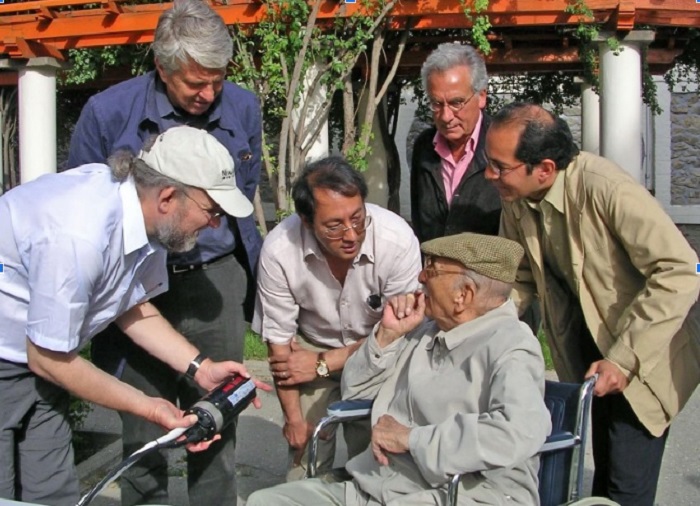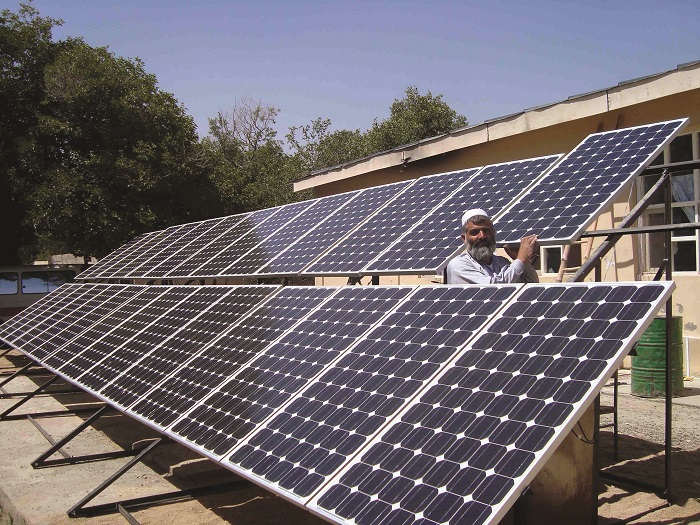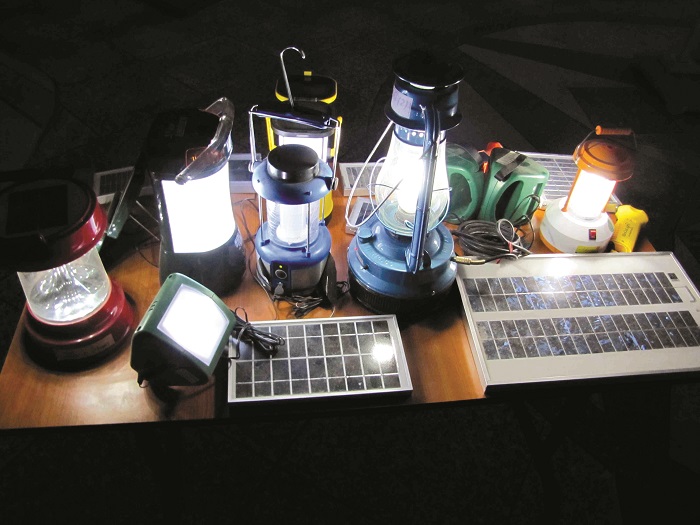
Renewable energy systems are often the most reliable options for supplying consistent power in conflict and war zones due to the systems’ decentralized nature. Onsite solar power systems — and mini-grids in particular — can save lives in many ways. They power health clinics and hospitals that care for the wounded. They quietly power security perimeter sensors and cameras as well as onsite security lighting. They reduce the need to truck in expensive fuel across dangerous roadways that are subject to attack. They can safely purify available water onsite. And they inform the local populace about relevant news, events and announcements.
We electrified 32 clinics with PV systems in a dozen Afghan provinces. We also provided each clinic with a solar hot-water system. These health clinics typically serve over 200 patients per day. The system powers autoclaves, ventilators, microscopes, electrocardiograms, ultrasounds, infant warmers, and other medical equipment. It also powers lights and computers.
ACEP worked in collaboration with the Afghan Ministry of Public Health. The average solar clinic was saving about $500 a month in avoided generator fuel. Often, these clinics were the only sources of electrical power in their communities, so many community members also used them to charge mobile phones.
Each clinic was also provided a DC refrigerator for vaccines.

Our program electrified rural schools in Afghanistan. This included installation of two 2-kWp PV systems with inverters on coed schools in Yawkaland District near Band-e Amir National Park in Bamiyan.
These systems power lights, computers, projectors and more. They were installed at the request of the USAID Bamiyan Provincial Reconstruction Team in cooperation with the Wildlife Conservation Society.
Additional schools were electrified in Nuristan, powering computer laboratories for both adjacent boys’ and girls’ schools.
As sometimes is the case with development projects, there can be unintended consequences. We also provided some solar streetlights on the road intersection leading to a school. The Taliban quickly used them to conduct target practice at night from the nearby local police station. We had to quickly remove those particular solar streetlights to avoid unintended casualties.

We installed 735 solar streetlights throughout the country. Unlike previous solar streetlights used in Afghanistan that typically only lasted for a few months due to poor design and hardware, the ACEP solar-streetlight systems used 50% more solar and battery storage while providing 1/3 more light than those previously deployed in Afghanistan by previous projects.
The earlier lighting typically had failed within months due to using shallow-cycle batteries. The teams had the “lowest bid” procurement instead of the “best offer.” Most of the ACEP solar streetlights lasted about seven or eight years on average before the first battery replacements were required.
ACEP also served as a test bed for some early demonstration pilots using Japanese solar streetlights that use lithium-ion ultracapacitors that should provide over 50,000 hours of service before any replacements are needed.
These were installed at schools in Bamiyan and Nuristan. The last assessment conducted in 2019 showed that these streetlights were still working well after a decade despite frigid winters (often -20°F).
The program installed over two dozen PV water-pumping systems, with half of these in Nangarhar Province and the rest in Balkh, Bamiyan, Kapisa and Parwan. These pumps are mostly for school and community water-supply systems.
These direct-drive PV systems use high-quality AC pumps and should provide 20 or more years of useful service. They were used ostensibly for community water supply, but also often provided badly needed water for small-scale irrigation of farm plots.
The systems typically pumped from 25 to 40 cubic meters of water per day.
Typically, the most difficult part of the project was the ~10-month-long inefficient customs-clearance process at the port of Karachi in Pakistan.

Our team installed over 700 small solar home systems for seven villages in Khost Province. These newer systems represented a significant improvement over past systems installed in Afghanistan. Most of the earlier systems were plagued by problems due to undersized solar panels, inappropriate batteries such as ones for automobiles and undersized wires. The Ministry of Rural Rehabilitation and Development had prohibited PV systems in its programs as a result.
When I first arrived to work in Afghanistan in 2008, I was consistently told that PV did not work due to poor-quality Chinese PV modules. I finally convinced MRRD to take me out to some of these problem systems. The first thing I noticed is that they were using Japanese Kyocera modules. Their problems were systems-related and had to do with poor module tilt, wrong orientation, car batteries with shallow cycles, and undersized wires with high voltage drops across long wire runs.
We introduced quality systems through our new programs and capacity building.
Our program provided over 10,000 solar lanterns for different nomadic tribal people in Afghanistan. This included over 1,700 solar lanterns in Badakshan.
These small systems are used to assist rural nomads in Afghanistan with basic LED light to replace kerosene lamps and to provide an option for mobile phone charging.
ACEP distributed more than 1,600 of these lanterns to villagers in Kirghiz and Wakhi nomadic communities in the Badakshan province’s Wakhan Corridor. We worked in collaboration with the Wildlife Conservation Society. Additional lanterns were provided to the Kuchi people in eastern Afghanistan.

One of the world’s largest solar mini-grids was installed for Bamiyan in central Afghanistan in 2013. The 1-MWp PV/diesel hybrid mini-grid was installed by Sustainable Energy Services International for the New Zealand Ministry of Foreign Affairs.
I served as the commissioning engineer for this system in 2013. The installation began in 2012, with the system beginning operation in late 2013. The total project cost was $14.1 million, including all transmission and distribution lines and capacity building. After construction, the system was turned over to Da Afghanistan Breshna Sherkat, the national utility company.
SESI maintained close contact with the community, soliciting opinions and asking for support in construction and monitoring. All of the local laborers were hired from communities near the power-plant sites. Consumers use prepaid pay-as-you-go cards to purchase kWh.
Capacity building centered on educating DABS about how to operate and maintain the plant. In addition to the engineers, clerical and management staff were trained in how to properly manage an electrical distribution system, customer connections and an accurate accounting system.